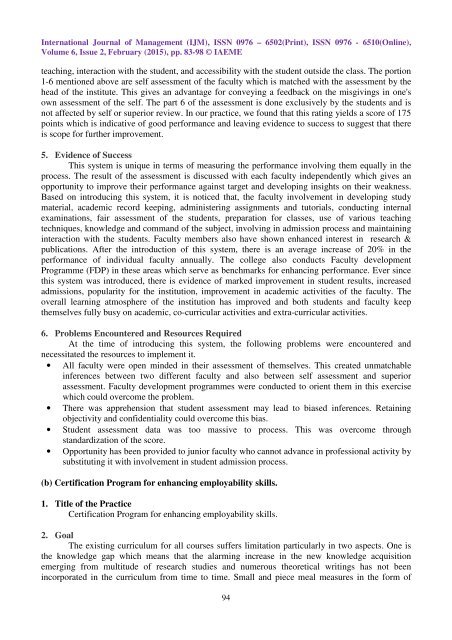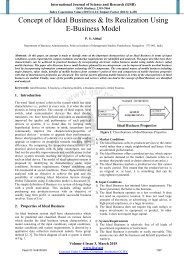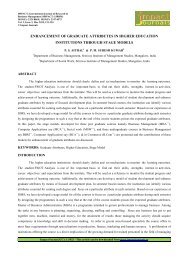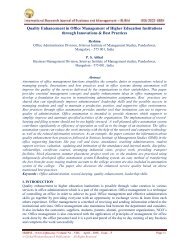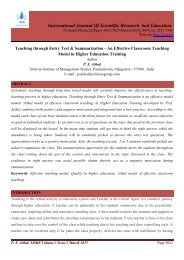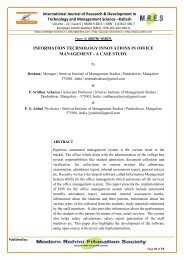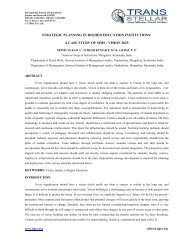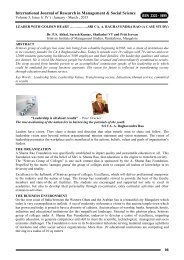How Innovations and Best Practices can Transform Higher Education Institutions : A case study of SIMS
Education has become competitive so as the educational institutions. In order to survive the competition, institutions have to improve the quality of their services. Changes in culture, aspiration and levels of skills required in securing employment for students, force higher education institutions today to rework on their educational models and add value to each and every aspect of their service. Innovations and best practices serve to enhance quality and add value. Srinivas Institute of Management Studies (SIMS), which combines technology, management and social service education has identified and implemented innovations and best practices to differentiate itself among the competitors and to add value in its educational services. In this paper, we have discussed innovations, small and big, develped indigineously and implemented during last four years. They are broadly classified under six key aspects namely "curricular aspects, teaching-learning and evaluation, research, consultancy and extension, infrastructure and learning resources, student support and progression, and governance, leadership, and management". The paper also contains some of the intitutional and individual faculty best practices having visible impact on the quality of higher education imparted by the institution. The best practices concern admission, fees, attendance, teaching, performance, skill building, employability, student involvement, collective learning, value addition, ensuring transparency, information dessimination etc. Finally two institutional best practices are elaborated with its aim of practice, underlying principles and concepts, particular contextual features or challenging issues that have had to be addressed in designing and implementing the practice, and its implementation, including its uniqueness in Indian higher education, evidence of success, identifying the problems encountered and resources required to implement the practice.
Education has become competitive so as the educational institutions. In order to survive the competition, institutions have to improve the quality of their services. Changes in culture, aspiration
and levels of skills required in securing employment for students, force higher education institutions
today to rework on their educational models and add value to each and every aspect of their service. Innovations and best practices serve to enhance quality and add value. Srinivas Institute of
Management Studies (SIMS), which combines technology, management and social service education
has identified and implemented innovations and best practices to differentiate itself among the competitors and to add value in its educational services. In this paper, we have discussed
innovations, small and big, develped indigineously and implemented during last four years. They are
broadly classified under six key aspects namely "curricular aspects, teaching-learning and evaluation, research, consultancy and extension, infrastructure and learning resources, student support and progression, and governance, leadership, and management". The paper also contains some of the
intitutional and individual faculty best practices having visible impact on the quality of higher education imparted by the institution. The best practices concern admission, fees, attendance, teaching, performance, skill building, employability, student involvement, collective learning, value
addition, ensuring transparency, information dessimination etc. Finally two institutional best practices are elaborated with its aim of practice, underlying principles and concepts, particular contextual features or challenging issues that have had to be addressed in designing and implementing the practice, and its implementation, including its uniqueness in Indian higher
education, evidence of success, identifying the problems encountered and resources required to implement the practice.
Create successful ePaper yourself
Turn your PDF publications into a flip-book with our unique Google optimized e-Paper software.
International Journal <strong>of</strong> Management (IJM), ISSN 0976 – 6502(Print), ISSN 0976 - 6510(Online),<br />
Volume 6, Issue 2, February (2015), pp. 83-98 © IAEME<br />
teaching, interaction with the student, <strong>and</strong> accessibility with the student outside the class. The portion<br />
1-6 mentioned above are self assessment <strong>of</strong> the faculty which is matched with the assessment by the<br />
head <strong>of</strong> the institute. This gives an advantage for conveying a feedback on the misgivings in one's<br />
own assessment <strong>of</strong> the self. The part 6 <strong>of</strong> the assessment is done exclusively by the students <strong>and</strong> is<br />
not affected by self or superior review. In our practice, we found that this rating yields a score <strong>of</strong> 175<br />
points which is indicative <strong>of</strong> good performance <strong>and</strong> leaving evidence to success to suggest that there<br />
is scope for further improvement.<br />
5. Evidence <strong>of</strong> Success<br />
This system is unique in terms <strong>of</strong> measuring the performance involving them equally in the<br />
process. The result <strong>of</strong> the assessment is discussed with each faculty independently which gives an<br />
opportunity to improve their performance against target <strong>and</strong> developing insights on their weakness.<br />
Based on introducing this system, it is noticed that, the faculty involvement in developing <strong>study</strong><br />
material, academic record keeping, administering assignments <strong>and</strong> tutorials, conducting internal<br />
examinations, fair assessment <strong>of</strong> the students, preparation for classes, use <strong>of</strong> various teaching<br />
techniques, knowledge <strong>and</strong> comm<strong>and</strong> <strong>of</strong> the subject, involving in admission process <strong>and</strong> maintaining<br />
interaction with the students. Faculty members also have shown enhanced interest in research &<br />
publications. After the introduction <strong>of</strong> this system, there is an average increase <strong>of</strong> 20% in the<br />
performance <strong>of</strong> individual faculty annually. The college also conducts Faculty development<br />
Programme (FDP) in these areas which serve as benchmarks for enhancing performance. Ever since<br />
this system was introduced, there is evidence <strong>of</strong> marked improvement in student results, increased<br />
admissions, popularity for the institution, improvement in academic activities <strong>of</strong> the faculty. The<br />
overall learning atmosphere <strong>of</strong> the institution has improved <strong>and</strong> both students <strong>and</strong> faculty keep<br />
themselves fully busy on academic, co-curricular activities <strong>and</strong> extra-curricular activities.<br />
6. Problems Encountered <strong>and</strong> Resources Required<br />
At the time <strong>of</strong> introducing this system, the following problems were encountered <strong>and</strong><br />
necessitated the resources to implement it.<br />
• All faculty were open minded in their assessment <strong>of</strong> themselves. This created unmatchable<br />
inferences between two different faculty <strong>and</strong> also between self assessment <strong>and</strong> superior<br />
assessment. Faculty development programmes were conducted to orient them in this exercise<br />
which could overcome the problem.<br />
• There was apprehension that student assessment may lead to biased inferences. Retaining<br />
objectivity <strong>and</strong> confidentiality could overcome this bias.<br />
• Student assessment data was too massive to process. This was overcome through<br />
st<strong>and</strong>ardization <strong>of</strong> the score.<br />
• Opportunity has been provided to junior faculty who <strong>can</strong>not advance in pr<strong>of</strong>essional activity by<br />
substituting it with involvement in student admission process.<br />
(b) Certification Program for enhancing employability skills.<br />
1. Title <strong>of</strong> the Practice<br />
Certification Program for enhancing employability skills.<br />
2. Goal<br />
The existing curriculum for all courses suffers limitation particularly in two aspects. One is<br />
the knowledge gap which means that the alarming increase in the new knowledge acquisition<br />
emerging from multitude <strong>of</strong> research studies <strong>and</strong> numerous theoretical writings has not been<br />
incorporated in the curriculum from time to time. Small <strong>and</strong> piece meal measures in the form <strong>of</strong><br />
94


